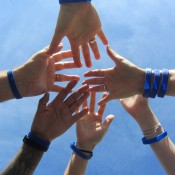A Balancing Act:
Improving Balance and Preventing Falls
by Sherry Olsen, PT
(Presented to Seattle Dizzy Group on 9/08/12)
Improving your balance can be a balancing act between presenting yourself with balance challenges and maintaining your safety and preventing falls. This presentation offers strategies for better balance and falls including prevention, how to fall, and how to get up if you do fall.
Balance – What Is It?
• Maintaining your center of gravity over the base of support
• Balance can be viewed as a motor skill that emerges from the interaction of multiple systems that are organized to meet functional task goals and that are constrained by environmental context.
» Fay Horak, 1997
How Do You Stay Balanced?
• Sensory information is picked up and sent through sensory neural pathways to the brain
• Processing of sensory information occurs in the central nervous system in several locations
• Motor output information is sent from the central nervous system through motor neural pathways to postural muscles that are activated to maintain balance
Sensory Information
Three main sensory inputs provide information about where the head and body are in space:
– Somatosensory system
– Visual system
– Vestibular system
Somatosensory System
• Provides information from proprioceptors in the joints and cutaneous sensory receptors touching the floor
• Fastest of the sensory pathways
• In normal stance, reliance on somatosensory information is 70%
Visual System
• Provides information about the position of the head with respect to the surroundings.
• Slower pathway as compared to the somatosensory pathway
• Loss or decrease in vestibular function increases visual dependence
• In normal stance, reliance on visual information is 10%
Vestibular System
• Provides internal reference point for head motion
• Detects both linear and rotational head movements
• Contributes both sensory input and motor output
• Sensitive to fast movements vs. slower movements
• In normal stance, reliance on vestibular information is 20%. With increasing perturbation, reliance on vestibular information increases to 70%.
Tips For Better Balance
Be attentive-
Balance is typically considered one of our automatic background functions yet we all demonstrate improved balance skills just by paying attention to what we are doing.
Utilize visual cues-
Vision provides an efficient way to orient ourselves in space compared with the horizon and other people and objects around us.
Using visual targets in the distance as a reference point can help.
Foot position matters-
Try various stance positions and see what feels more stable.
Use it or lose it-
Practice safe balance challenges frequently. The human brain is always able to adapt and improve with practice.
Weight shift to move your center of gravity over your base of support-
Moving your body toward the limit of stability in all directions helps fine-tune your brain’s awareness of your limits and improves standing balance.
Aerobic endurance is key-
Exercise that focuses on aerobic endurance is the most important for good balance.
Maintain hip and ankle strength and flexibility-
Strength in the hips and ankles improve stability.
Flexibility improves the ability to make small corrections to maintain balance. Both strength and flexibility are needed for appropriate postural reactions.
Work on core strength and postural alignment-
Engaging core abdominal muscles stabilizes the center of the body. Maintaining good posture keeps the center of gravity over the base of support.
Eyes and head must work together-
It is cruicial for eye movements and head movements to be aligned. Using points of reference while turning your head can increase stability.
Maintain a consistent schedule-
Keeping a consistent wake and sleep cycle makes it much easier for the brain to function efficiently. Good sleep is important.
What you ingest is important-
Avoid foods that irritate or cause fluctuation in brain function.
Take time for calming and centering activities-
Give yourself time every day to participate in a relaxation routine. Identify stressors and develop coping strategies. Do things that make you feel happy, safe, secure and grounded. These activities will build up reserves to carry you through stressful times.
What Is A Fall?
• An unexpected event in which participants come to rest on the ground floor or lower level.
» Prevention of Falls Network Europe Consensus 2005
Fall Classifications
Intrinsic
– Impaired vision, dementia, vestibular deficit
Extrinsic
– Environment, medication, footwear
Fall Prevention Strategies
• Begin a regular exercise program
• Make the home safer
• Have your health care provider review your medications
• Have your vision checked
– Centers for Disease Control and Prevention
How To Fall And How To Get Up
• If you can tell that a fall is going to occur, it’s better to roll into the fall. Try not to extend or stiffen any joints. This can prevent injuries.
• If you do fall, using a piece of furniture for support can help aid with getting up. If you can come up on one knee then stand up, that usually works best.
References
• Advanced Intervention for Fall Prevention, presented by Laurie Swan, PT, DPT, PhD, Spring PTWA Conference, April 2012.
• Pacific Balance September newsletter, “Tips for Better Balance” by Chris Morrow, PT, NCS, September 2012.
• Vestibular Rehabilitation, Third Edition, Susan J. Herdman, 2007.
Sherry Olsen, PT
Sherry Olsen has a diverse background in treating patients with orthopedic, neurological, and vestibular conditions. Currently, Sherry has focused her practice on helping patients overcome dizziness and balance issues. She has worked to educate both patients and therapists about vestibular diagnoses and treatment and has given several lectures to fellow therapists. Sherry is a certified vestibular specialist educated from the State University of New York at Stony Brook. Sherry is a member of the American Physical Therapy Association and the Washington Physical Therapy Association.







Leave a comment